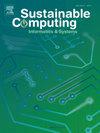A comprehensive IoT and blockchain-integrated framework for autonomous water management in sustainable urban ecosystems
IF 5.7
3区 计算机科学
Q1 COMPUTER SCIENCE, HARDWARE & ARCHITECTURE
引用次数: 0
Abstract
Different approaches to urbanization, decaying infrastructure, and climate change may blend into multiple pressures on the urban water management system. It would turn the limelight towards the intrinsic weaknesses of the systems in terms of traditional, centralized-inherently reactive, opaque, and unreliable-public systems. This proposed research brings a new decentralized paradigm synergistically utilizing IoT, blockchain technology, and machine learning in mutual respect and strength for resilient urban ecosystems. The architecture consists of IoT sensors for real-time monitoring and data collection, with water quality sensors and flow meters sending data through edge devices to a blockchain network, thereby ensuring integrity, security, and resistance to tampering. Respectively, machine learning algorithms embedded in the system will use historical and real-time data to perform predictive analytics to forecast future water demand and detect water-quality anomalies. This multi-layer architecture allows for real-time monitoring, transparency, automated decision-making, and intelligent resource reallocation. The results show significant improvements: predictive analytics for water demand forecasting achieved an F1-score of 91 %; the blockchain achieved 95 % fault tolerance; and energy efficiency improved by as much as 75 % at low-load conditions. Furthermore, the system provided low-latency communication and high transactions throughput, proving its scalability and applicability in different urban settings.
一个全面的物联网和区块链集成框架,用于可持续城市生态系统中的自主水管理
不同的城市化方式、老化的基础设施和气候变化可能会给城市水管理系统带来多重压力。它将把人们的注意力转向传统的、集中的、固有的反应性、不透明和不可靠的公共系统的内在弱点。本研究提出了一种新的去中心化模式,在相互尊重和力量的基础上,协同利用物联网、区块链技术和机器学习,为有弹性的城市生态系统提供了一种新的模式。该架构由物联网传感器组成,用于实时监控和数据收集,水质传感器和流量计通过边缘设备将数据发送到区块链网络,从而确保完整性、安全性和抗篡改性。系统中嵌入的机器学习算法将分别使用历史和实时数据进行预测分析,以预测未来的用水需求并检测水质异常。这种多层体系结构允许实时监控、透明、自动决策和智能资源重新分配。结果表明:预测分析对需水量预测的f1得分达到91 %;区块链实现了95% %的容错性;在低负荷条件下,能源效率提高了75% %。此外,该系统提供了低延迟通信和高事务吞吐量,证明了其在不同城市环境中的可扩展性和适用性。
本文章由计算机程序翻译,如有差异,请以英文原文为准。
求助全文
约1分钟内获得全文
求助全文
来源期刊

Sustainable Computing-Informatics & Systems
COMPUTER SCIENCE, HARDWARE & ARCHITECTUREC-COMPUTER SCIENCE, INFORMATION SYSTEMS
CiteScore
10.70
自引率
4.40%
发文量
142
期刊介绍:
Sustainable computing is a rapidly expanding research area spanning the fields of computer science and engineering, electrical engineering as well as other engineering disciplines. The aim of Sustainable Computing: Informatics and Systems (SUSCOM) is to publish the myriad research findings related to energy-aware and thermal-aware management of computing resource. Equally important is a spectrum of related research issues such as applications of computing that can have ecological and societal impacts. SUSCOM publishes original and timely research papers and survey articles in current areas of power, energy, temperature, and environment related research areas of current importance to readers. SUSCOM has an editorial board comprising prominent researchers from around the world and selects competitively evaluated peer-reviewed papers.
 求助内容:
求助内容: 应助结果提醒方式:
应助结果提醒方式:


